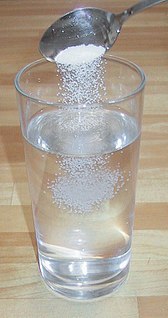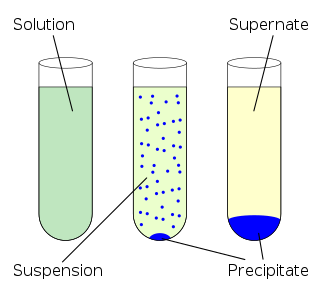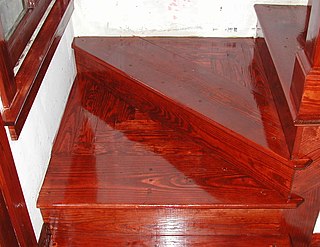Universal solvent may refer to:
- Water, described as the "universal solvent" for its ability to dissolve many substances
- Alkahest, a hypothetical solvent able to dissolve every other substance
- The Universal Solvent , a comic by Don Rosa
Universal solvent may refer to:

An acid–base reaction is a chemical reaction that occurs between an acid and a base. It can be used to determine pH. Several theoretical frameworks provide alternative conceptions of the reaction mechanisms and their application in solving related problems; these are called the acid–base theories, for example, Brønsted–Lowry acid–base theory.

Evaporation is a type of vaporization that occurs on the surface of a liquid as it changes into the gas phase. The surrounding gas must not be saturated with the evaporating substance. When the molecules of the liquid collide, they transfer energy to each other based on how they collide with each other. When a molecule near the surface absorbs enough energy to overcome the vapor pressure, it will escape and enter the surrounding air as a gas. When evaporation occurs, the energy removed from the vaporized liquid will reduce the temperature of the liquid, resulting in evaporative cooling.

In chemistry, a solution is a special type of homogeneous mixture composed of two or more substances. In such a mixture, a solute is a substance dissolved in another substance, known as a solvent. The mixing process of a solution happens at a scale where the effects of chemical polarity are involved, resulting in interactions that are specific to solvation. The solution usually has the state of the solvent when the solvent is the larger fraction of the mixture, as is commonly the case. One important parameter of a solution is the concentration, which is a measure of the amount of solute in a given amount of solution or solvent. The term "aqueous solution" is used when one of the solvents is water.

A solvent is a substance that dissolves a solute, resulting in a solution. A solvent is usually a liquid but can also be a solid, a gas, or a supercritical fluid. The quantity of solute that can dissolve in a specific volume of solvent varies with temperature. Major uses of solvents are in paints, paint removers, inks, dry cleaning. Specific uses for organic solvents are in dry cleaning, as paint thinners, as nail polish removers and glue solvents, in spot removers, in detergents and in perfumes (ethanol). Water is a solvent for polar molecules and the most common solvent used by living things; all the ions and proteins in a cell are dissolved in water within the cell. Solvents find various applications in chemical, pharmaceutical, oil, and gas industries, including in chemical syntheses and purification processes.

Solvation describes the interaction of solvent with dissolved molecules. Both ionized and uncharged molecules interact strongly with solvent, and the strength and nature of this interaction influence many properties of the solute, including solubility, reactivity, and color, as well as influencing the properties of the solvent such as the viscosity and density. In the process of solvation, ions are surrounded by a concentric shell of solvent. Solvation is the process of reorganizing solvent and solute molecules into solvation complexes. Solvation involves bond formation, hydrogen bonding, and van der Waals forces. Solvation of a solute by water is called hydration.

Solubility is the property of a solid, liquid or gaseous chemical substance called solute to dissolve in a solid, liquid or gaseous solvent. The solubility of a substance fundamentally depends on the physical and chemical properties of the solute and solvent as well as on temperature, pressure and presence of other chemicals of the solution. The extent of the solubility of a substance in a specific solvent is measured as the saturation concentration, where adding more solute does not increase the concentration of the solution and begins to precipitate the excess amount of solute.

An aqueous solution is a solution in which the solvent is water. It is mostly shown in chemical equations by appending (aq) to the relevant chemical formula. For example, a solution of table salt, or sodium chloride (NaCl), in water would be represented as Na+(aq) + Cl−(aq). The word aqueous (which comes from aqua) means pertaining to, related to, similar to, or dissolved in, water. As water is an excellent solvent and is also naturally abundant, it is a ubiquitous solvent in chemistry. Aqueous solution is water with a pH of 7.0 where the hydrogen ions (H+) and hydroxide ions (OH−) are in Arrhenius balance (10−7).

Varnish is a clear transparent hard protective finish or film. It is neither a paint nor stain. In its native state it has little or no color, but may be pigmented as desired, and is sold commercially in various shades.

A tincture is typically an extract of plant or animal material dissolved in ethanol. Solvent concentrations of 25–60% are common, but may run as high as 90%. In chemistry, a tincture is a solution that has ethanol as its solvent. In herbal medicine, alcoholic tinctures are made with various ethanol concentrations, which should be at least 20% alcohol for preservation purposes.

Alkahest is a theorized "universal solvent", which was believed to be capable of dissolving any other substance, including gold, without altering or destroying its components. The famous alchemist Philippus Paracelsus described alkahest in the 1500s. Because of its perceived invaluable medicinal qualities, alchemists of the time were concerned with its plausibility and existence. As the shift of alchemy went from transmuting metals to creating remedies, the alkahest became valued for its ability to break down substances to their base virtues/properties, which included healing properties. Thus it was sought after for its potential to cure incurable diseases at the time, for example, the breaking down of Ludus could provide a cure for urinary calculi.
Leaching is the loss or extraction of certain materials from a carrier into a liquid. and may refer to:
Lipophilicity, refers to the ability of a chemical compound to dissolve in fats, oils, lipids, and non-polar solvents such as hexane or toluene. Such non-polar solvents are themselves lipophilic, and the axiom that "like dissolves like" generally holds true. Thus lipophilic substances tend to dissolve in other lipophilic substances, but hydrophilic ("water-loving") substances tend to dissolve in water and other hydrophilic substances.
A diluent is a diluting agent. Certain fluids are too viscous to be pumped easily or too dense to flow from one particular point to the other. This can be problematic, because it might not be economically feasible to transport such fluids in this state. To ease this restricted movement, diluents are added. This decreases the viscosity of the fluids, thereby also decreasing the pumping/transportation costs.

Paper chromatography is an analytical method used to separate coloured chemicals or substances. Erwin Chargaff credits in Weintraub's history of the man the 1944 article by Consden, Gordon and Martin with sparking his discovery of Chargaff's rules, an important precursor to Watson and Crick's discovery of the double-helix structure of DNA, for which they were awarded the Nobel Prize in Physiology or Medicine in 1962. It is now primarily used as a teaching tool, having been replaced in the laboratory by other chromatography methods such as thin-layer chromatography (TLC).
Cleaning agents or hard-surface cleaners are substances used to remove dirt, including dust, stains, bad smells, and clutter on surfaces. Purposes of cleaning agents include health, beauty, removing offensive odor, and avoiding the spread of dirt and contaminants to oneself and others. Some cleaning agents can kill bacteria and clean at the same time. Others, called degreasers, contain organic solvents to help dissolve oils and fats.
Stain removal is the process of removing a mark or spot left by one substance on a specific surface like a fabric. A solvent or detergent is generally used to conduct stain removal and many of these are available over the counter.

Leaching is the process of a solute becoming detached or extracted from its carrier substance by way of a solvent.

Hash oil, also known as honey oil or cannabis oil, is an oleoresin obtained by the extraction of cannabis or hashish. It is a cannabis concentrate containing many of its resins and terpenes – in particular, tetrahydrocannabinol (THC), cannabidiol (CBD), and other cannabinoids. There are various extraction methods, most involving a solvent, such as butane or ethanol. Hash oil is usually consumed by smoking, vaporizing or eating. Hash oil may be sold in cartridges used with pen vaporizers. Preparations of hash oil may be solid or colloidal depending on both production method and temperature and are usually identified by their appearance or characteristics. Color most commonly ranges from transparent golden or light brown, to tan or black. Cannabis retailers in California have reported about 40% of their sales are from cannabis oils. Hash oil is an extracted cannabis product that may use any part of the plant, with minimal or no residual solvent. It is generally thought to be indistinct from traditional hashish, according to the 1961 UN Single Convention on Narcotic Drugs, as it is "the separated resin, whether crude or purified, obtained from the cannabis plant".

A hydrophile is a molecule or other molecular entity that is attracted to water molecules and tends to be dissolved by water.